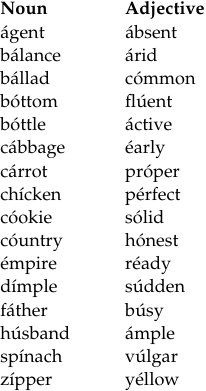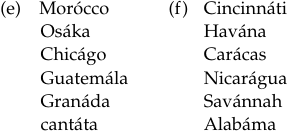

Grammar


Tenses


Present

Present Simple

Present Continuous

Present Perfect

Present Perfect Continuous


Past

Past Continuous

Past Perfect

Past Perfect Continuous

Past Simple


Future

Future Simple

Future Continuous

Future Perfect

Future Perfect Continuous

Passive and Active


Parts Of Speech


Nouns

Countable and uncountable nouns

Verbal nouns

Singular and Plural nouns

Proper nouns

Nouns gender

Nouns definition

Concrete nouns

Abstract nouns

Common nouns

Collective nouns

Definition Of Nouns


Verbs

Stative and dynamic verbs

Finite and nonfinite verbs

To be verbs

Transitive and intransitive verbs

Auxiliary verbs

Modal verbs

Regular and irregular verbs

Action verbs


Adverbs

Relative adverbs

Interrogative adverbs

Adverbs of time

Adverbs of place

Adverbs of reason

Adverbs of quantity

Adverbs of manner

Adverbs of frequency

Adverbs of affirmation


Adjectives

Quantitative adjective

Proper adjective

Possessive adjective

Numeral adjective

Interrogative adjective

Distributive adjective

Descriptive adjective

Demonstrative adjective


Pronouns

Subject pronoun

Relative pronoun

Reflexive pronoun

Reciprocal pronoun

Possessive pronoun

Personal pronoun

Interrogative pronoun

Indefinite pronoun

Emphatic pronoun

Distributive pronoun

Demonstrative pronoun


Pre Position


Preposition by function

Time preposition

Reason preposition

Possession preposition

Place preposition

Phrases preposition

Origin preposition

Measure preposition

Direction preposition

Contrast preposition

Agent preposition


Preposition by construction

Simple preposition

Phrase preposition

Double preposition

Compound preposition


Conjunctions

Subordinating conjunction

Correlative conjunction

Coordinating conjunction

Conjunctive adverbs


Interjections

Express calling interjection


Grammar Rules

Preference

Requests and offers

wishes

Be used to

Some and any

Could have done

Describing people

Giving advices

Possession

Comparative and superlative

Giving Reason

Making Suggestions

Apologizing

Forming questions

Since and for

Directions

Obligation

Adverbials

invitation

Articles

Imaginary condition

Zero conditional

First conditional

Second conditional

Third conditional

Reported speech


Linguistics

Phonetics

Phonology


Semantics


Pragmatics

Linguistics fields

Syntax

Morphology

Semantics

pragmatics

History

Writing

Grammar

Phonetics and Phonology


Reading Comprehension

Elementary

Intermediate

Advanced


Teaching Methods

Teaching Strategies
Noun and Adjective Stress
المؤلف:
Mehmet Yavas̡
المصدر:
Applied English Phonology
الجزء والصفحة:
P157-C7
2025-03-14
258
Noun and Adjective Stress
There seem to be sufficient commonalities between the stress patterns of nouns and adjectives that they warrant a single grouping. In disyllabics, the default stress is on the penult. In a 20,000-monomorphemic-word sample reported by Hammond (1999: 194), both disyllabic nouns and adjectives reveal penult stress over 80 percent of the time. More precisely, 81.7 percent (2,986 out of 3,652) of nouns and 81 percent (1,047 out of 1,294) of disyllabic adjectives followed this pattern. Below are some examples from both categories:

The exceptions to the penult rule fall into two groups. The first contains examples with weightless (unstressable) penults, because they have [ə] nuclei, and thus are stressed on the final syllable (ult) by default; for this reason, they might be considered exceptions:

The second group constitutes the real exceptions because they are stressed on the final syllable (ult) despite the fact that they have stressable penults with branching rhymes:

In trisyllabic and longer nouns, we formulate the following: stress penult if stressable (heavy/branching rhyme); if not stressable, then stress the next left heavy syllable. We show this with the following examples:

The words in the leftmost group are stressed on the penult because their penults are stressable (the first five qualify for their long vowel or diphthong nuclei, and the last four because of the closed rhyme). The words in the second trisyllabic group receive their stresses on the antepenult because their penults are not stressable (all with [ə] nuclei). The rightmost group consists of words that have more than three syllables, but the stress rule remains the same. The first word, barracuda, is stressed on the penult, as it contains a stressable penult, [u]. The remaining words (seven with four syllables, and the last one with five syllables) all have unstressable penults ([ə] nuclei) and thus are stressed on the antepenult. As for the frequency of such patterns, Hammond reports that this regularity accounts for over 90 percent of nouns (42 percent or 859 out of 2,074 trisyllabics have penult stress, and 49.5 percent or 1,027 out of 2,074 are antepenult-stressed because of unstressable penult). The exceptions, exemplified by the following, are below 10 percent:

These examples, mostly borrowings from French, retain the original final stresses. Most of these exceptional words have unstressable penults, and thus the rule predicts that the stress would go on the antepenult instead of the ult, a tendency revealed by several native speakers for the last 4–5 words on the list.
Some other trisyllabic exceptions, on the other hand, receive antepenult stress despite the fact that they have stressable penults, as shown in:

There is another group of words, trisyllabic or longer, that deserves attention. The words in this group, overwhelmingly coming from place-names, are stressed on the penult, despite the fact that it is not heavy, as exemplified below:

The stressed penults of these words (a)–(d) do not have branching rhymes (the rhymes are /ɑ/, /ε/, /Λ/, and /æ/ respectively).
There are some other words, again mostly place-names, which also carry the stress on their non-heavy penult:

The penults in words (e) and (f), /ɑ/ and /æ/ respectively, do not constitute heavy syllables, but are stressed, nevertheless. However, these words are somewhat different than the violations observed in words (a)–(d), because words in (e) and (f) do not have any other heavy syllable to the left of the penult (they all have [ə] nuclei). In other words, the stress is on the penult by default.
Trisyllabic adjectives, of which there are far fewer, also show a similar pattern to that of nouns. Hammond reports that over 90 percent of trisyllabic adjectives follow the expected path: 75.3 percent (502 out of 666) with penult stress, and 15 percent (100 out of 666) with antepenult stress because of unstressable penult.